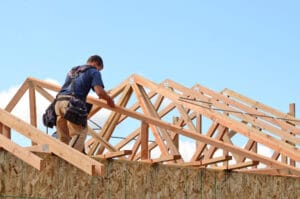A study by economists at the UMass Donahue Institute, commissioned by the Healey administration, says the governor’s $4.12 billion housing finance and policy bill, and housing-related tax breaks passed last year, will give more than a five-fold boost to the state economy over five years.
The state Executive Office of Housing and Livable Communities released the study Thursday.
The spending and policy changes intended to make housing easier to build will fuel 18,800 construction and development jobs, catalyze $6.6 billion private investment in affordable housing construction and generate new tax revenue for the state and municipalities, the study argues. In total, these benefits will add up to $15.5 billion, the researchers wrote.
“We know the path to economic success: it starts with housing,” Gov. Maura Healey said in a statement. “The results of the Donahue study underscore that. Hardworking Massachusetts families need access to housing they can afford. The production of that housing creates jobs and can be a driving force for our economy. The Affordable Homes Act is the urgent action we need to build a stronger Massachusetts.”
The study focused on Healey’s proposed bill’s affordable housing subsidies and three policy changes: allowing the construction of accessory dwelling units by-right on single-family lots statewide, selling or leasing surplus state land for housing construction and allowing towns and cities to levy a sales tax on property transactions over $1 million. It also included boosts to the state’s existing Low-Income Housing Tax Credit and market-rate Housing Development Incentive Program tax break programs that were proposed by Healey and passed by the state legislature as part of last year’s tax legislation. The two pieces of legislation together will generate $24.8 billion in economic activity, the study found.
“Accessible and affordable housing is the key to unlocking Massachusetts as a competitive state,” Lt. Gov. Kim Driscoll said in a statement. “Housing is jobs. Not only for people supporting the building trades, but all the people connected with it.”
However, the researchers noted that their calculations rely on an expansion of the state’s construction workforce, something that’s proved elusive in prior years.
“The stimulus provided by the [Healey bill] is large and is anticipated to occur over an accelerated timeline. As such, meeting these demands will require a large and rapid expansion of the construction sector. This pressure will come with downsides, most especially delays and higher costs. On the other hand, a reliable source of multiyear demand will also incentivize business formation, investment, and workforce development,” the researchers wrote.
The Donahue Institute study came as Harvard’s Joint Center for Housing Studies released its annual analysis of renter cost burdens. The metropolitan area-level research found that the Pioneer Valley has the highest share of its residents paying large shares of their incomes towards rent. Nearly 33,000 of the region’s renter households – fully one-third of all renters in the area – pay more than 50 percent of their income towards their apartments, and 56.1 percent pay more than 30 percent of their income, for a total of nearly 56,000 renter families facing cost burdens.
The most many homebuyers are usually allowed to pay towards monthly mortgage costs is 45 percent if they have excellent credit and good savings, and 36 percent if they have normal credit and a typical level of savings, based on rules set by mortgage-buyer Fannie Mae.
The Harvard report found that Cape Cod renters face the next-highest burden level, with 30.5 percent paying more than 50 percent of their income and 51.7 percent paying more than 30 percent.
Boston-area renters were next, with over 203,000 renter households – 27.1 percent of all renter families – paying more than 50 percent of their income towards rent and a total of over 390,000 paying more than 30 percent of their income to rent.
In Worcester, 25.9 percent of renter households pay more than half their income to rent and 49 percent pay more than 30 percent. On Martha’s Vineyard, those figures were 21.4 percent and 50.9 percent respectively; in the Berkshires, they were 24.1 percent and 41.9 percent.







